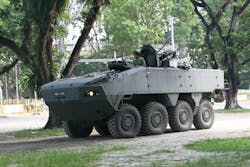Marines choose SAIC and BAE Systems to develop new amphibious armored combat vehicle
QUANTICO, Va. - U.S. Marine Corps amphibious warfare experts are choosing BAE Systems and Science Applications International Corp. (SAIC) to develop advanced versions of a new amphibious armored combat vehicle and accompanying vetronics to replace an aging fleet of amphibious assault vehicles (AAVs).
Officials of the Marine Corps Systems Command at Quantico Marine Base, Va., announced contracts to SAIC and BAE Systems to build 13 advanced prototypes of Amphibious Combat Vehicles (ACVs) in a program called ACV 1.1. The Marines will choose one of these companies in 2018 for full-scale ACV production.
The ACV will be a wheeled armored combat vehicle able to move Marine infantry warfighters from ships offshore to fight their way onto invasion beaches. Marine Corps leaders have reasonable costs in mind for the ACV project after having cancelled the expensive expeditionary fighting vehicle (EFV) program in 2011.
Both companies are basing their ACV designs on foreign-built armored personnel carriers. BAE Systems is basing its ACV design on the Superav 8x8 amphibious armored personnel carrier developed by the Italian company Iveco Defence Vehicles. SAIC, meanwhile, is basing its ACV design on the Terrex 8X8 armored personnel carrier from ST Engineering in Singapore.
The BAE Systems contract is for $121.5 million, while the SAIC contract is for $103.8 million. Each contract has options to build three additional Amphibious Combat Vehicles that include different configurations and weapons systems for separate missions.
Each contract has options to build 60 low-rate initial production vehicles and 148 full-rate production vehicles.
Companies that competed for the ACV contracts but that were not selected include General Dynamics Corp. and Lockheed Martin Corp. It wouldn't be a surprise to see General Dynamics or Lockheed Martin protest the contracts to SAIC and BAE Systems.
The BAE Systems and SAIC teams are building ACV systems able to operate through enemy direct fire, indirect fire, and land mines with low-profile visual and infrared signatures, modular protection, and other armored vehicle technologies.
The vehicles will be able to swim to shore from as far as 12 miles out to sea, switch from operating in the water to ground operations without pause, and then maneuver with M1 Abrams main battle tanks in a mechanized task force. The ACV will be able to destroy relatively light enemy combat vehicles similar to itself.
The ACV will provide direct fire support for Marine infantry, and will be able to carry 17 Marines at speeds of at least eight knots at sea amid three-foot waves with waves as large as three feet.
On shore, the ACV will have high-ground clearance and a V-shaped hull to resist the effects of land mine blasts, and will be able to operate with a wheel blown off.
Each ACV will have a crew of three and an M2 .50-caliber machine gun in a remote weapons station, with the potential to install a stabilized dual-mount M2/Mark 19 grenade launcher turret.
On these contracts, SAIC will do its work in Charleston, S.C., and BAE Systems will do its work in York, Pa. Both companies should be finished by September 2017.
FOR MORE INFORMATION visit SAIC online at www.saic.com, BAE Systems at www.baesystems.com, or Marine Corps Systems Command at www.marcorsyscom.marines.mil.

